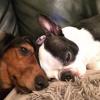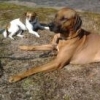-
Hvem er aktive 0 medlemmer
- Ingen innloggede medlemmer aktive
-
Nye innlegg
-
Det er mye spam for tiden, vi jobber med å løse problemet. Ikke klikk på noen lenker, og rapportere gjerne. Moderator og admin sletter og sperrer fortløpende.
-
Var det jeg var redd for...
-
Han har det godt i buret. Det står på et varmt underlag og han har myk madrass og tepper. Mer enn nok plass til å snu seg som han vil. Han har vannskål festet på ene burveggen og må han tisse, piper han så jeg går ut med han. Det er ikke bur som er et problem her. Han legger seg inn i det frivillig på dagtid også når han skal sove.
-
Buret er veldig begrensende, og hunder bruker ulike liggestillinger og underlag for å regulere varmen i løpet av natten. Hunder ligger gjerne stille der fordi de ikke har noe valg. Hvis valpen må gjøre fra seg eller søler når han drikker så blir det fort vått og ubehagelig å ligge der også. Lykke til med kattetreningen, du har nok en jobb foran deg der. Selv om det har gått bra før så er individer forskjellige og har ulike grader av instinkter.
-
Ja, han visste at jeg hadde katter, men mente det ikke var noe problem. Og jeg har hatt både jakthunder og gjeterhunder tidligere og det har gått veldig bra. Valpen ligger fint i buret så jeg skjønner ikke helt hvorfor jeg skal endre på det? Buret står i stuen og valpen sover rolig hele natten der.
-
-
Nylig opprettede emner



Recommended Posts
Join the conversation
You can post now and register later. If you have an account, sign in now to post with your account.